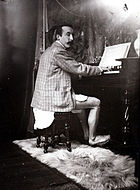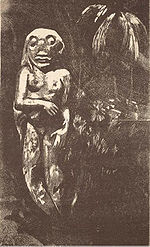- Oviri (Gauguin)
-
Oviri 
Artist Paul Gauguin Year 1894/1895 Type Stoneware Dimensions 75 cm × 19 cm (29.5 in × 7.5 in) Location Musée d'Orsay, Paris Oviri (Savage in Tahitian[1]) is a stoneware ceramic sculpture created from partially glazed stoneware by the French artist Paul Gauguin (1848-1903) in the winter of 1894/95. The work depicts the Goddess Oviri, a Tahitian deity of death and mourning, whose name translates as "savage" or "wild".[2] She is shown strangling a blood stained wolf cub at her hip, while another wolf lies dead under her feet.
Gauguin often used the epithet of Oviri for himself; he saw himself as a "civilised savage"[3] and referred to this sculpture as "La tueuse", The Killer.[4] Shortly before he died he wrote, "I am a savage. And the civilized feel it from the outset: because in my work there is nothing which surprises or ... am a savage in spite of myself."[1]
Ultimately the sculpture became Gauguin's grave monument.[5]
Contents
Background
 Paul Gauguin playing the harmonium in Alphonse Mucha's studio at rue de la Grande-Chaumière, Paris, 1895
Paul Gauguin playing the harmonium in Alphonse Mucha's studio at rue de la Grande-Chaumière, Paris, 1895
Primarily a painter, Gauguin came to ceramics around 1886, when he was taught the craft by the French potter Ernest Chaplet (1835-1909). Félix Bracquemond had introduced Chaplet to Gauguin [6] who, stimulated by the new French art pottery, was experimenting with the form. During that winter of 1886-7, Gauguin attended the Vaugirard studio and with Chaplet created some 55 stoneware pots with applied figures or ornamental fragments, multiple handles, painted and partially glazed.[7] The venture was intended to function as an extra source of income, and though he declared it one of the best works he has produced, it did not sell, and was to be his final ceramic.
Description
Gauguin's Oviri has long blond / grey hair which reaches to her knees. Her head is disproportionately large, as are her eyes, while she has adolescent breasts.[1] She is depicted clutching a wolf cub to her hip, which she appears to be strangling, intended as a symbol of her wild power,[8] and more abstractly, the indifference of nature.[1] A second animal, likely another wolf, is shown at her feet either curling in submission or dead; according to some art historians this may represent Gauguin himself.[4]
 Gauguin, Oviri 1894, (after the ceramic original). Woodcut printed in brown ink on wove paper, 20.3 x 12.7 cm (8 x 5 in), Museum of Fine Arts, Boston
Gauguin, Oviri 1894, (after the ceramic original). Woodcut printed in brown ink on wove paper, 20.3 x 12.7 cm (8 x 5 in), Museum of Fine Arts, Boston
Gauguin described the character of the woman as "monstrous and majestic, drunk with pride, rage and sorrow".[9] According to the art historian Christopher Gray (1915-1970), the sculpture represents "the expression of Gauguin's profound disillusionment and discouragement".[10] Gauguin first visited Tahiti in 1891, and was taken by the beauty of Tahitian women and set about painting a set of sculptural mask-like portraits on paper. Evoking a sense of both melancholy and death, Gauguin intended his portraits to conjure the Tahitian state of "faaturuma", or resignation; imagery he later called upon for his Oviri ceramic. It is likely that he modeled this work from a wood carving.[11] Gauguin also made several woodcuts depicting the goddess,[4] as well as an 1894 self-portrait in patinated plaster entitled Oviri (Savage).[1]
In 2000, a bronze cast version of the work cast circa 1950-1960 sold at Christies for $64,625.[8] Today, the original 1894 stoneware sculpture is in the Musée d'Orsay in Paris.[10]
Notes
- ^ a b c d e Cachin, 208
- ^ Maurer, 162
- ^ van der Grijp, 126
- ^ a b c Gedo, John. "[The Inner World of Paul Gauguin]". The Annal of Psychoanalysis, Volume 22. Routledge, 1994. ISBN 0-8816-313-53
- ^ Landy, Barbara. "The Meaning of Gauguin's 'Oviri' Ceramic". The Burlington Magazine, Volume 109, No. 769, April 1967. 242, 244-246
- ^ Image&Narrative, The Monstrous and the Grotesque: Gauguin’s Ceramic Sculpture, Yeon Shim Chung (Shim Chung), 2008, retrieved February 27, 2009
- ^ Metropolitan Museum of Art timeline. Retrieved February 27, 2009
- ^ a b "Lot 106 / Sale 9518". Christies.com. Retrieved on February 21, 2009.
- ^ Taylor, Sue. "Oviri: Gauguin's savage woman". Journal of Art History, Volume 62, Issue 3 / 4, 1993. 197 - 220
- ^ a b "Oviri". Musée d'Orsay. Retrieved on February 21, 2009.
- ^ "Important and Rare Paul Gauguin Sculpture Up for Auction at Sotheby's". sgallery.net. April 29, 2008. Retrieved on February 22, 2009.
Sources
- Cachin, Francoise. "Gauguin". Flammarion, 1990. ISBN 2-0803-0430-5
- Maurer, Naomi E. "The Pursuit of Spiritual Wisdom". Fairleigh Dickinson University Press, 1998. ISBN 0-8386-3749-3
- Gray, Christopher, Sculpture and Ceramics of Paul Gauguin, Baltimore: Johns Hopkins Press, 1963
- van der Grijp, Paul. Art and Exoticism: an Anthropology of the Yearning For: Authenticity. Lit Verlag, 2009. ISBN 3-8258-1667-2
Paul Gauguin Paintings List of paintings · Vision after the Sermon (1888) · The Painter of Sunflowers (1888) · The Yellow Christ (1889) · The Green Christ (1889) · Tahitian Women on the Beach (1891) · Spirit of the Dead Watching (1892) · Where Do We Come From? What Are We? Where Are We Going? (1897/1898) · Two Tahitian Women (1899)Other works Jug in the form of a Head, Self-portrait (1889) · Oviri (1895)Exhibitions Public collections Family Friends Art dealers Wikimedia Categories:- 1895 works
- 19th-century sculptures
- Collections of the Musée d'Orsay
Wikimedia Foundation. 2010.
